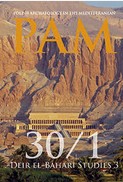What an artist saw: Tracing a local iconographic tradition for the Temple of Hatshepsut at Deir el-Bahari
What an artist saw: Tracing a local iconographic tradition for the Temple of Hatshepsut at Deir el-Bahari
Author(s): Anastasiia Stupko-LubczyńskaSubject(s): Archaeology, Cultural history, Visual Arts, Local History / Microhistory, Ancient World, History of Art
Published by: Wydawnictwa Uniwersytetu Warszawskiego
Keywords: Deir el-Bahari; Asasif; Hatshepsut; Mentuhotep II Nebhepetra; Theban tombs; visitor’s inscriptions; artists; decoration; friezes of objects; linen;
Summary/Abstract: An unusual iconographic motif—a fringed piece of linen—depicted in the Chapel of Hatshepsut, part of the queen's temple at Deir el-Bahari, is examined in this paper as an illustration of the interest, well attested in Hatshepsut's reign, in past artistic models/sources. The Chapel of Hatshepsut was intended for the mortuary cult of the female pharaoh, while the motif under discussion appears to have been inspired by decoration earlier by 500 years, found inside a burial chamber cut into the rock cliff of North Asasif, which is a natural continuation of the Deir el-Bahari amphitheater. The tomb (TT 311) belonged to Khety, a courtier of the Eleventh-Dynasty pharaoh Mentuhotep II Nebhepetra. Assuming the validity of this iconographic link, the question arises concerning the accessibility of decorated burial chambers from the Eleventh Dynasty in this area and their possible role as “pattern books” in the design of the early Eighteenth Dynasty private and royal mortuary monuments. In addition, the paper addresses the issue of the Chapel of Hatshepsut serving as a monumental “pattern book” for the Late Period Theban tombs.
Journal: Polish Archaeology in the Mediterranean
- Issue Year: 1/2021
- Issue No: XXX
- Page Range: 187-214
- Page Count: 28
- Language: English

